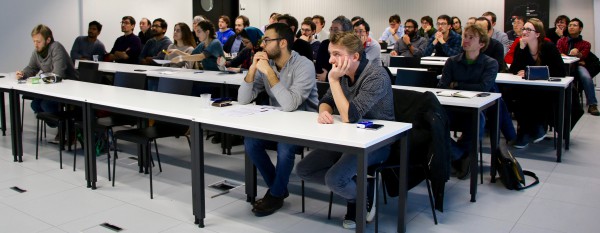MARVEL Junior Seminar — April 2018
The MARVEL Junior Seminars aim to intensify interactions between the MARVEL Junior scientists belonging to different research groups located at EPFL. The EPFL community interested in MARVEL research topics is very welcome to attend. We believe that these events will be central for establishing a vibrant community.
Each seminar consists of two presentations of 25 minutes each, allowing to present on a scientific question in depth, each presentation being followed by 10 minutes for discussion. The discussion is facilitated and timed by the chairperson of the day whose mission is to ensure active lively interactions between the audience and the speakers.
Pizza is served as of 11:45 in the MED hall (floor 0), and after the seminar at 13:30 you are cordially invited for coffee and dessert to continue discussion with the speakers.

MARVEL Junior Seminar Organizing Committee — Ariadni Boziki, Francesco Ambrosio, Davide Campi, Edgar Engel, Gloria Capano, Michele Pizzochero, Quang Van Nguyen, Kun-Han Lin, Francesco Maresca and Nathalie Jongen
Check the list of the next MARVEL Junior Seminars here.
Abstract — First principles description of Cu2V2O7: electron-hole interaction and thermal effects - Igor Reshetnyak
Several complex metal oxides have attracted much attention recently due to their potential applications as photoanodes for water-splitting photochemical cells. In particular, copper vanadate (Cu2V2O7) has been suggested as a promising candidate material, based, in particular, on simple optical band-gap analysis. However, its final photo-chemical efficiency has been found lower than expected. To understand this behaviour, we performed ab-initio calculations of the absorption spectra of Cu2V2O7 within the framework of the Bethe-Salpeter Equation based on the GW approximation to the self-energy, including effects of spin-orbit coupling, nuclear quantum motion and thermal vibrations. We showed that the low-lying excitations are strongly bound and thus cannot be used efficiently for water-splitting. Furthermore, we explored different approaches to combining electron-hole interaction and thermal effects and showed that the correct treatment of both of them is crucial for obtaining good agreement with experiments.
Authors: Igor Reshetnyak, Julia Wiktor, Alfredo Pasquarello
Abstract — High-Throughput Screening of Novel 2D Support Materials for Catalysis - Kun-Han Lin
The oxygen evolution reaction (OER) remains the bottleneck reaction in water splitting due to its considerable overpotential. One of the key objective is thus to achieve superior electrocatalysts, which avoid the scaling relationship of the surface bound intermediates (*-OH and *-OOH) leading to the overpotential. Recently, Corminboeuf and Hu, exploited an alternative mechanism for the OER involving a hydrogen acceptor support material. In this context, it becomes appealing to search for potential hydrogen acceptor candidates in an effective and efficient way. Automated AiiDA workflows have proven to be very effective for the high-throughput screening many materials - such as Li-ion batteries and light-harvesting applications. Therefore, our goal is to take advantage of this strategy to screen for potential hydrogen acceptor candidates for the OER. We focus on 2D support materials, given that exfoliated 2D layered structures were found to possess a larger activity than their 3D analogues. While only a limited amount of 2D materials have been experimentally synthesized or exfoliated to date, Mounet et al. constructed a 2D-material database (exfoliable materials) through the high-throughput computational exfoliation of experimentally known inorganic compounds. We here exploit and extend this automated workflow to identify suitable hydrogen-location and potential hydrogen acceptor candidates.
Low-volume newsletters, targeted to the scientific and industrial communities.
Subscribe to our newsletter